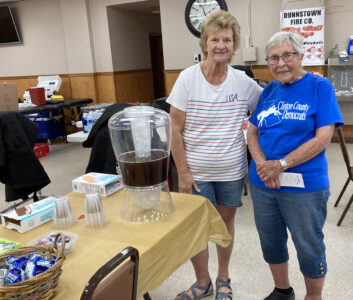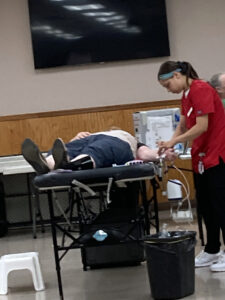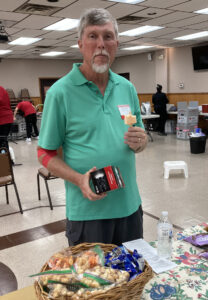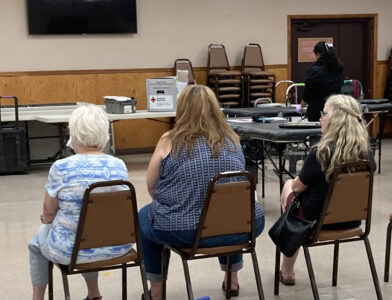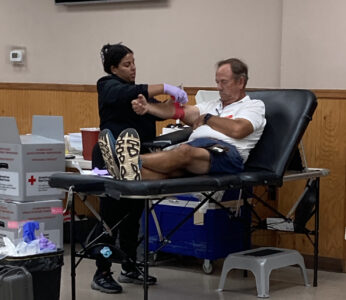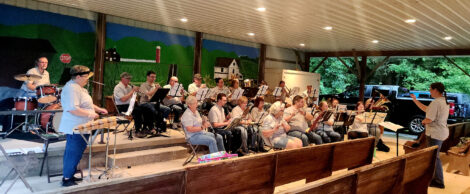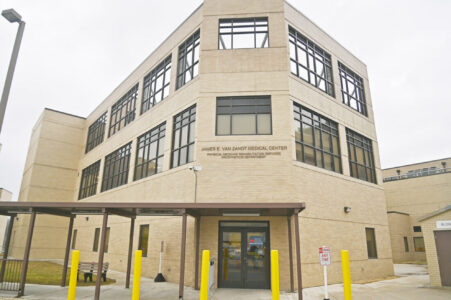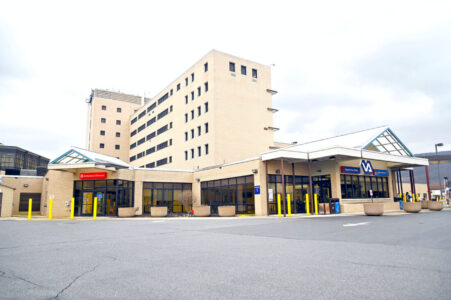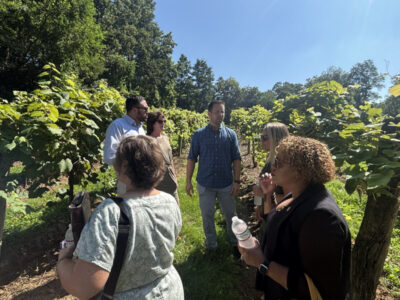Constantly needed: Local blood drive organizer, Red Cross talk about importance of donations
- PHOTO PROVIDED Two volunteers for the Clinton County Democratic Women Committee man the refreshment table, where donors enjoy a treat and ensure they’re safely able to leave the blood drive.
- PHOTO PROVIDED A Red Cross employee completes a blood donation with a volunteer at a recent blood drive held by the Clinton County Democratic Women Committee at Dunnstown Fire Hall.
- PHOTO PROVIDED Ronald Shoemaker enjoys a treat after donating blood. He also received a solar powered lamp from the Red Cross for his donation, which he is seen holding.
- PHOTO PROVIDED A group of donors wait for their turn at a blood drive at the Dunnstown Fire Hall.
- PHOTO PROVIDED Walter Eisenhauer completes a blood donation at a recent blood drive held at the Dunnstown Fire Hall by the Clinton County Democratic Women Committee.
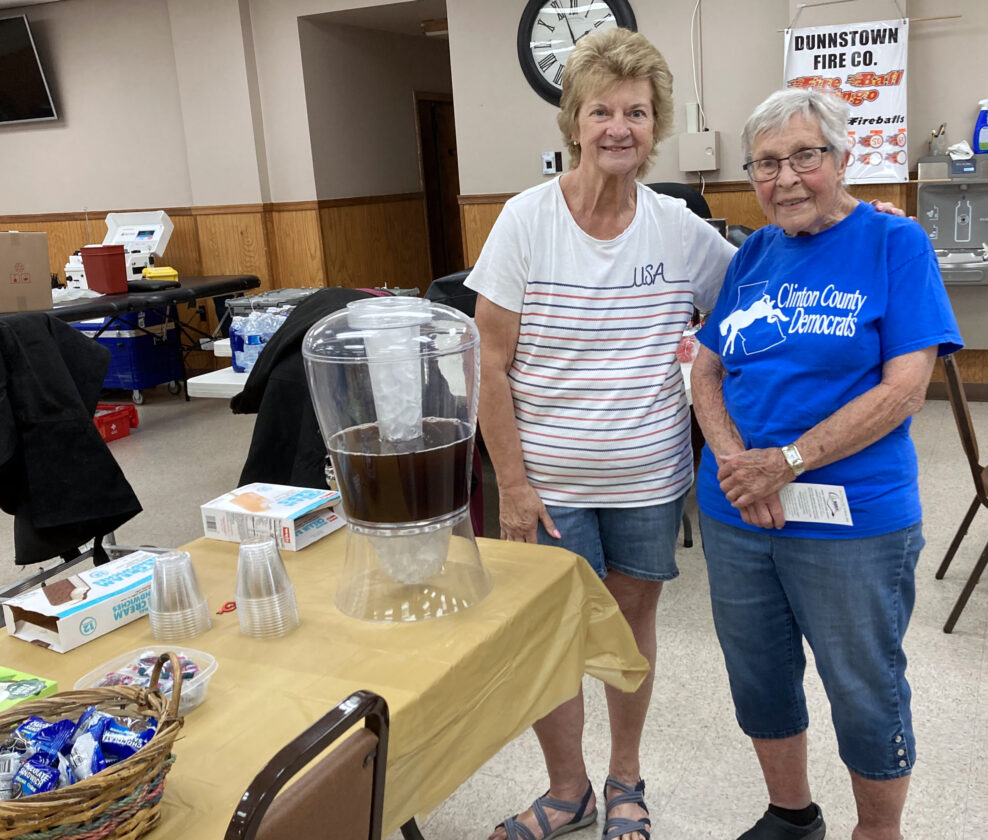
PHOTO PROVIDED Two volunteers for the Clinton County Democratic Women Committee man the refreshment table, where donors enjoy a treat and ensure they’re safely able to leave the blood drive.
LOCK HAVEN — The need for blood donations is a constant for the American Red Cross, and there are local volunteers and organizations that look to help.
“The need for blood is constant — every two seconds, someone in the U.S. needs lifesaving blood. This includes accident and burn victims, new moms and premature babies or those in treatment for cancer or sickle cell disease,” said Cristina Masiel, regional communication manager for the Red Cross.
According to the Red Cross’s numbers, the organization must collect more than 12,000 blood donations every day nationwide to ensure there is enough for those in need.
Maisel noted that, during the summer months, “blood donations often don’t keep pace with patient needs.”
“Because blood cannot be stockpiled, full summer calendars, travel plans and severe weather can quickly impact the blood supply. That’s why it’s so important for people to make and keep their blood donation appointments this summer,” she said.
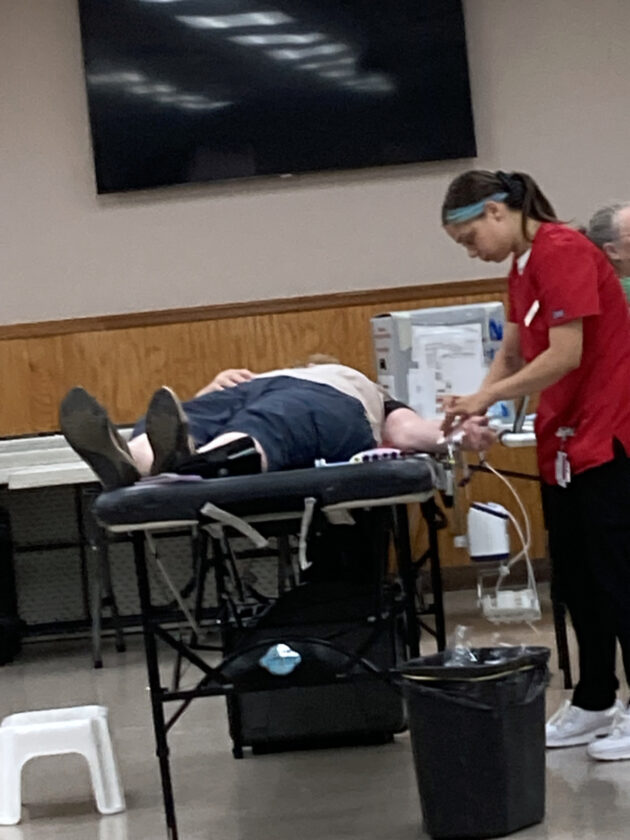
PHOTO PROVIDED A Red Cross employee completes a blood donation with a volunteer at a recent blood drive held by the Clinton County Democratic Women Committee at Dunnstown Fire Hall.
Locally, a variety of churches, non-profits and other organizations hold blood drives year round in an effort to contribute to the cause.
Rose Reeder, a member of the Clinton County Democratic Women Committee, recently organized a blood drive on behalf of the committee at the Dunnstown Fire Hall in August.
She told The Express they had 42 open appointments and saw a decent turnout for the event.
“For the first time we filled every appointment. To me, that is wonderful. It is the first time we have done that in six events,” she said.
To make it happen, she said over a month she sent out emails, posted the event on Facebook and put flyers up around town.
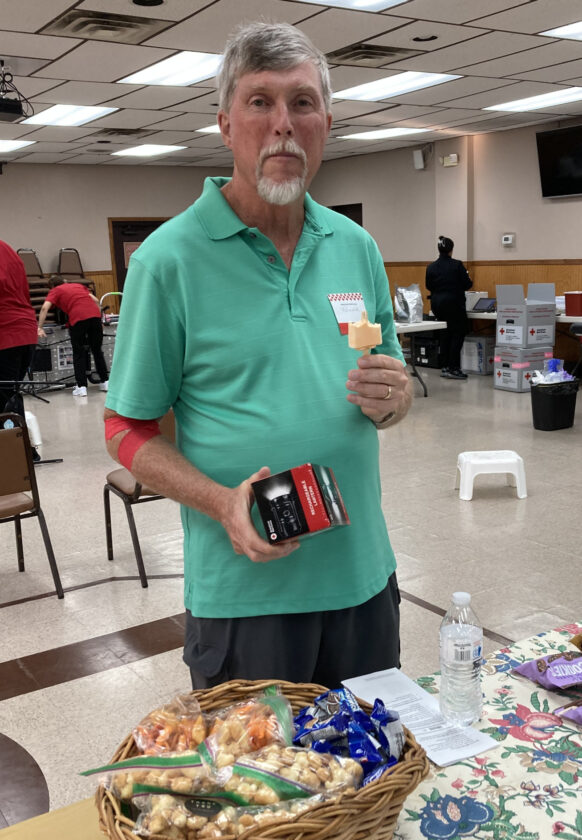
PHOTO PROVIDED Ronald Shoemaker enjoys a treat after donating blood. He also received a solar powered lamp from the Red Cross for his donation, which he is seen holding.
In total the drive managed to collect 28 pints of blood.
“Of course there are always people who are deferred or cannot give blood,” she explained. “For that reason, we always expect to collect less than the appointment number.”
Reeder explained a variety of reasons people can be deferred include a heart rate of 100 or, in women, hemoglobin under 12.5 g/dl.
Having organized multiple blood drives, Reeder said she often runs into people who are unwilling to donate due to a fear of needles or having a busy schedule.
“Each individual has their own personal reason but the common ones that come to mind include fear, people’s lives are too busy, jobs, the time is just not convenient, misinformation, illness, underestimating how great the need for blood is or the feeling that someone else will do it,” she said. “I am surprised when I try to recruit folks, that many are afraid of needles and can’t even talk about the process.”
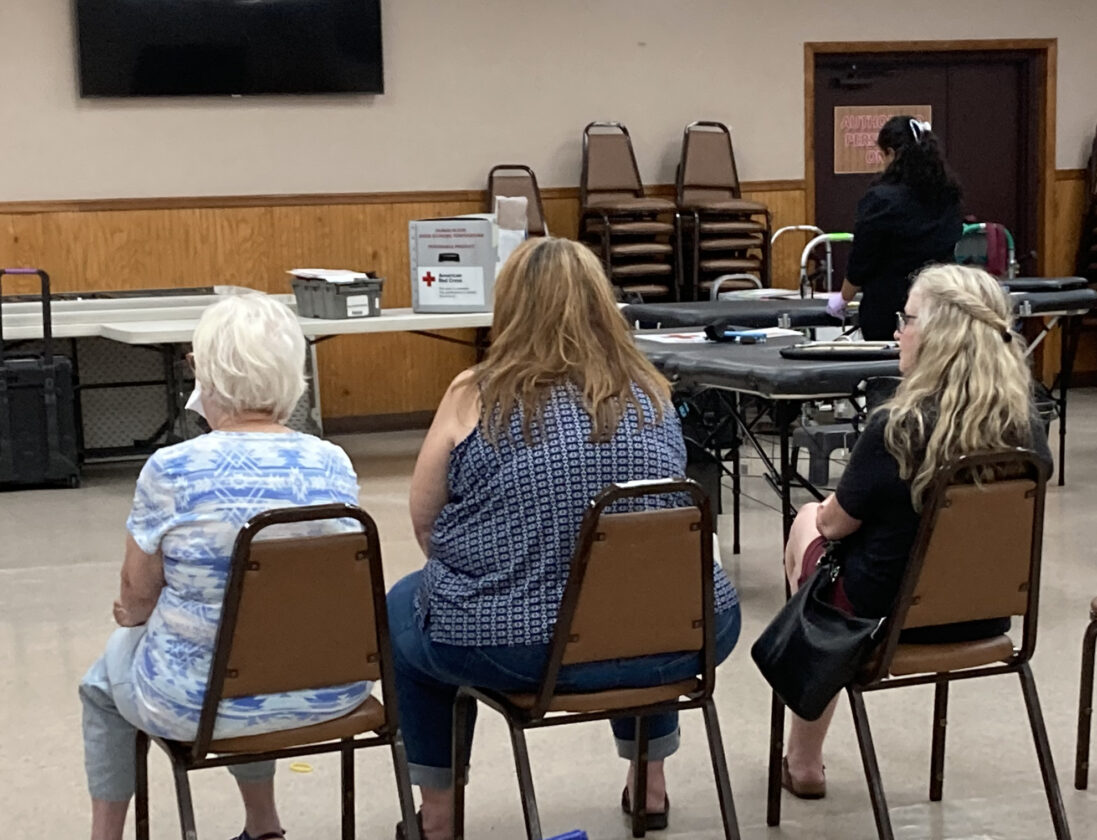
PHOTO PROVIDED A group of donors wait for their turn at a blood drive at the Dunnstown Fire Hall.
Both Reeder and Maisel said the process to sign up for a blood drive is very simple, and the donation itself is relatively quick.
Those interested in finding local blood drives to sign up for can do so online at www.redcross.org.
“A typical blood donation appointment takes about an hour, but the actual donation itself is only about 8 to 10 minutes,” Maisel said.
Maisel shared the following steps for the typical process to donate:
— Step one: Registration upon arrival where a donor would sign in and provide ID.
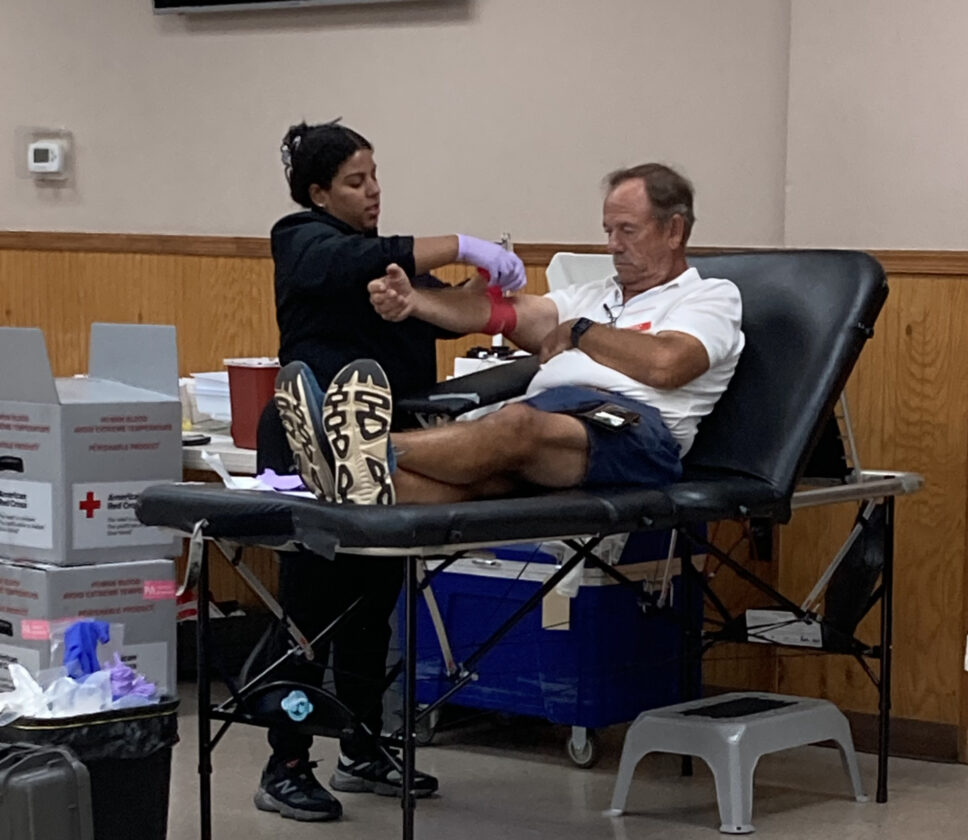
PHOTO PROVIDED Walter Eisenhauer completes a blood donation at a recent blood drive held at the Dunnstown Fire Hall by the Clinton County Democratic Women Committee.
— Step two: The Health History Process where potential donors are asked about their personal health history, medications and places traveled in a private and confidential interview. This includes mini-physicals to check temperature, hemoglobin, blood pressure and pulse.
— Step three: The donation. Staff clean the donor’s arm, following a quick pinch approximately a pint of blood is collected, and lasts about 8 to 10 minutes.
— Step four: Refreshment and recovery where donors enjoy a snack and juice or water. Donors are asked to leave after about 10 to 15 minutes.
“Donating blood is a simple act that can make a big difference in the lives of others. We encourage all donors to give blood this summer to make the world brighter for patients in need,” Maisel said.
If you’re unable to donate, organizing a drive in your local area can also be a way to help the Red Cross reach its goals all year round.
According to Reeder, the process to organize a blood drive involves a lot of responsibility but isn’t difficult.
“The Red Cross depends on you to secure a place and donors,” she explained.
Beyond this, Red Cross staff handle the blood donation process.
When an organization or individual agrees to hold a drive, Reeder said there are three tasks that must be done:
“You must find a venue that is large and clean. We always go to the Dunnstown Fire Hall, they are wonderful to work with and it is a perfect place,” she said.
Another job, she said, is to be committed to filling up the sign up sheet.
“There are folks who give blood as often as they are permitted and they simply sign up that way,” she explained. Otherwise, putting information out online, in local media or by hanging posters in local businesses, are other avenues to encourage individuals to sign up.
The third important step is to find volunteers.
“I always create a special snack table because I think it becomes an attraction to repeat donors. The Red Cross always offers a special reward for donors,” she said. During the recent drive Reeder helped organize, the organization offered solar power lanterns.
She noted the Red Cross offers her detailed instructions throughout the entire process and added a manager from the organization also offers answers to questions and guidance.
Information about how to hold a drive, or to sign up for a local blood drive, can be found at www.redcrossblood.org.
Reeder noted the website is thorough and provides information about anything you need, from donating yourself to setting up a drive.
“The Red Cross team deserves a heartfelt note of gratitude. They travel everyday, sometimes long distances. They arrive and drag all kinds of heavy equipment into the room, set up and are ready to go in a short time,” she said. “They are on their feet for more than six hours as they tend to the donors.”
Reeder further noted their knowledge, efficiency and pleasant demeanor throughout the drive.
“I couldn’t be more impressed with them,” she said.

